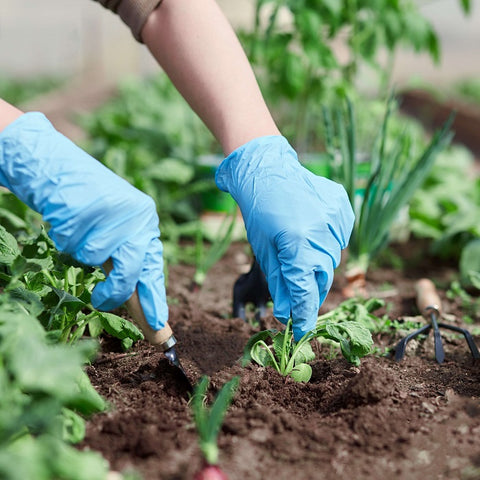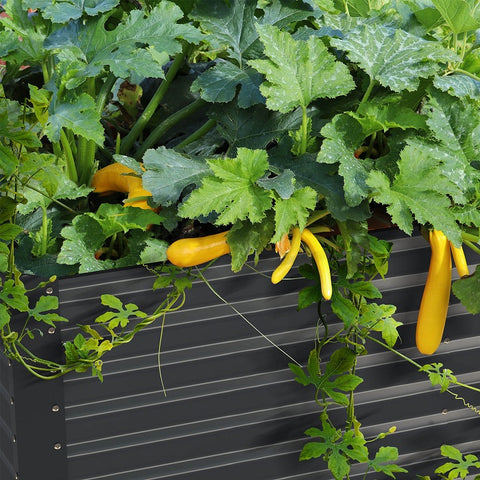How do you know when and how much to water your vegetables? It's not hard, but you should know the specific nuances of watering your vegetables so you can get a better handle on it. For example, watering seedlings is different from watering vegetable plants. Irrigation beds are different from irrigation containers. It's better to water in the morning than at noon.Knowing these differences can maximize your watering efficiency. Here are the worst mistakes to avoid so your vegetables get all the water they need for a healthy harvest.The following content also has some reference value for raised garden beds.
- Seedlings are not watered enough.
The newly planted seedlings must not be short of water. Because their roots are still developing, newly planted seedlings need a steady supply of water - never let them dry out! Water the seedbed lightly every morning and check it again at night. If a dry crust forms on the surface of the soil, it is difficult for new seeds to germinate. If the budding seed dries out, it may die.
- You don't know how often to water your garden.
You need to know how often to water the garden for the plants to grow smoothly. While daily watering is essential for seedlings to germinate, mature plants should be watered differently. Frequent shallow watering can perk up your plants in the short term, but it can also promote shallow root growth. This causes plants to dry out quickly when the soil surface is dry, which can happen quickly on hot, sunny days. When you water deeply, the roots will grow down a few inches past the top, where they are better protected from rapid moisture fluctuations and less likely to dry out. Deep soaks two or three times a week (considering rain) will be healthier and more productive than frequent shallow soaks. Wetting the surface of the soil with an extra soak after a rain shower can soak the soil to a depth of several inches, providing plenty of drinks for your plants.
- You water too often
As with flowers, the rarest cause of many vegetable problems is too much watering.Novice vegetables tend to be full of expectations for the vegetables, every day would like to see seven or eight times, looking at unconsciously to pour some water to the vegetables, lest the drought.As a result, the poor vegetables died from too much water. Many pro are morning and evening each watering once, so it is a little too much ~So how often should I water it? How much water should I water every day? To be honest, there is no right answer, just follow the rule: water only when it is slightly dry.Because vegetable roots can only absorb the tiny water molecules that are stored between the soil particles, and they also need enough air (which is why the soil is breathable) to keep the roots' cells active, moderate soil redrying is essential.Vegetables drown or rot to the roots, usually because the soil is so saturated that the roots can't breathe, causing them to suffocate.
A common test to see if it's time to water is to dig your finger into the soil and water it if it's dry inside, but not if it's dry outside but still wet inside (you can also use a wooden pole or something else instead).
After water pouring more vegetables will generally appear as follows:
Bare, crazy long stems, long legs.
Leaves yellow, a lot of people mistakenly think is lack of fertilizer, but actually in the seedling stage will rarely have a lack of fertilizer, most of the water is big.
Rotted roots: When you dig up a dead plant and find that the roots have rotted away.
- Underwatered containers and raised beds.
Vegetables and herbs grown in containers or raised beds require more water than those grown in underground beds. Why? First, the soil mixture used for containers and lifting beds is designed to drain faster than the soil in underground beds. Second, because their soil is above ground level, temperatures rise rapidly on warm days, increasing evaporation.
Periodically check the moisture levels of containers and planting beds by inserting a hygrometer or finger a few inches into the soil. If the soil is dry, it's time to water.

- Water at the wrong time.
The best time to water your garden is in the morning, as leaves are likely to get wet and have plenty of time to dry before evening. Watering in the heat of the day is less efficient; Water evaporates more quickly and less reaches the roots. At night, when temperatures drop, evaporation slows again, but cooler nighttime temperatures also facilitate the spread of certain foliar diseases. If you must water at night, avoid wetting the leaves.
- Water the leaves.
Plants get water through their roots, not their leaves. Water directly onto the surface of the soil to avoid wetting the leaves, as water can spread some plant diseases. Use watering sticks to water the ground, or use a hose or drip irrigation system to wet the soil instead of the leaves.
- Sprinkle soil on the leaves.
The soil can harbor many plant diseases. These diseases can spread if soil is splashed onto plant leaves while watering, so use a mild spray or soaking hose. Also, putting a two-inch layer of mulch around your crop, which tends to cause some leaf diseases, such as tomatoes, helps keep soil from splashing around









